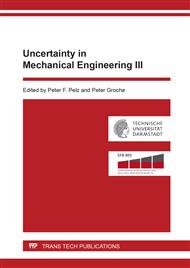[1]
Dj.M. Maric, P.F. Meier and S.K. Estreicher: Mater. Sci. Forum Vol. 83-87 (1992), p.119.
Google Scholar
[2]
H. Agarwal et al. Uncertainty Quantification Using Evidence Theory in Multidisciplinary Design Optimization,. In: Reliability Engineering and System Safety 85.1-3 (July 2004), pp.281-294. ISSN: 09518320.
DOI: 10.1016/j.ress.2004.03.017
Google Scholar
[3]
T. Augustin et al., eds. Introduction to Imprecise Probabilities. Wiley Series in Probability and Statistics. Chichester, UK: John Wiley and Sons, Ltd, May 9, 2014. ISSN: 978-1-118-76311-7.
DOI: 10.1002/9781118763117.scard
Google Scholar
[4]
M. Fuchs. Clouds, p-Boxes, Fuzzy Sets, and Other Uncertainty Representations in Higher Dimensions,. In: Acta Cybernetica 19.1 (2009), pp.61-92. ISSN: 0324-721X. DOI: 10.14232/ actacyb.19.1.2009.5.
DOI: 10.14232/actacyb.19.1.2009.5
Google Scholar
[5]
W. Graf, J.-U. Sickert, and F. Steinigen. Numerical Simulation of Structures Using Generalized Models for Data Uncertainty,. In: WIT Transactions on Modelling and Simulation. Vol. 48. May 20, 2009, pp.511-521.
DOI: 10.2495/CMEM090461
Google Scholar
[6]
J. Helton et al. A Sampling-Based Computational Strategy for the Representation of Epistemic Uncertainty in Model Predictions with Evidence Theory,. In: Computer Methods in Applied Mechanics and Engineering 196.37-40 (Aug. 2007), pp.3980-3998.
DOI: 10.1016/j.cma.2006.10.049
Google Scholar
[7]
G. J. Klir. Generalized Information Theory: Aims, Results, and Open Problems,. In: Reliability Engineering and System Safety 85.1-3 (July 2004), pp.21-38. ISSN: 09518320. DOI: 10.1016/ j.ress.2004.03.003.
DOI: 10.1016/j.ress.2004.03.003
Google Scholar
[8]
B. Möller and M. Beer. Fuzzy Randomness. Berlin, Heidelberg: Springer Berlin Heidelberg, 2004. ISSN: 978-3-642-07312-0.
Google Scholar
[9]
B. Möller and U. Reuter. Uncertainty Forecasting in Engineering: With 15 Tables. OCLC: 255434772. Berlin: Springer, 2007. 202 pp. ISSN: 978-3-540-37173-1.
Google Scholar
[10]
B. Möller et al. Numerical Simulation Based on Fuzzy Stochastic Analysis,. In: Mathematical and Computer Modelling of Dynamical Systems 13.4 (Aug. 2007), pp.349-364. ISSN: 1387- 3954, 1744-5051.
DOI: 10.1080/13873950600994514
Google Scholar
[11]
W. L. Oberkampf. Uncertainty Quantification Using Evidence Theory,. In: Proceedings from the Advanced Simulation and Computing Workshop. (2005).
Google Scholar
[12]
G. Presser. DEMPSTER-SHAFER Evidenztheorie - Versuch einer anschaulichen Einführung. Forschungsbericht 729. Universität Dortmund, May 18, 2000, pp.19-24. DOI: 10 . 17877 / DE290R-14881.
Google Scholar
[13]
K. Sentz and S. Ferson. Combination of Evidence in Dempster-Shafer Theory. SAND2002- 0835. Albuquerque, NM: Sandia, (2002).
DOI: 10.2172/800792
Google Scholar
[14]
A. F. Shapiro. A Fuzzy Random Variable Primer,. In: Actuarial Research Clearing House. Itasca, Ill.: Committee on Research of the Society of Actuaries, (2008).
Google Scholar
[15]
J.-U. Sickert. Fuzzy-Zufallsfunktionen Und Ihre Anwendung Bei Der Tragwerksanalyse Und Sicherheitsbeurteilung,. TU Dresden, (2005).
Google Scholar
[16]
T. Simpson et al. Metamodels for Computer-Based Engineering Design: Survey and Recommendations,. In: Engineering with Computers 17.2 (July 2001), pp.129-150. DOI: 10.1007/ PL00007198.
DOI: 10.1007/pl00007198
Google Scholar
[17]
P. Smets. Imperfect Information: Imprecision and Uncertainty,. In: Uncertainty Management in Information Systems. Ed. by A. Motro and P. Smets. Boston, MA: Springer US, 1997, pp.225-254. ISSN: 978-1-4613-7865-5.
DOI: 10.1007/978-1-4615-6245-0_8
Google Scholar
[18]
P. Walley. Towards a Unified Theory of Imprecise Probability,. In: International Journal of Approximate Reasoning 24.2-3 (May 2000), pp.125-148. ISSN: 0888613X. DOI: 10 . 1016 / S0888-613X(00)00031-1.
DOI: 10.1016/s0888-613x(00)00031-1
Google Scholar


